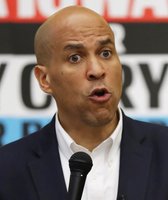Stand up for the facts!
Our only agenda is to publish the truth so you can be an informed participant in democracy.
We need your help.
I would like to contribute
As you begrudgingly finish this year’s tax returns, the last thing you want to do is think about tax days to come. But after 2017, your taxes may be significantly different depending on who’s in the White House.
Republicans Donald Trump and Ted Cruz are both promising significant tax cuts across the board, largely benefitting the wealthy. Trump also wants to use the tax code to encourage companies to do business at home, while Cruz is for a one-rate-fits-all approach. John Kasich hasn’t released a formal tax plan or enough details for analysis.
On the Democratic side, Bernie Sanders is also advocating radical changes to the tax code, but he wants higher taxes on the super rich and to fund new government programs. Hillary Clinton targets the top income earners for tax increases through policy-specific tweaks, but her plan is hardly a revolution. (See our interactive chart at the end of this report.)
The Democrats’ plans, according to analysis by the free market-oriented Tax Foundation and the nonpartisan Tax Policy Center, would bring in revenue, but not necessarily economic growth. Conversely, the Republicans’ plans might stimulate the economy, but they would also bloat the deficit.
So what exactly are the remaining presidential candidates proposing and how will their plans affect you?
Donald Trump’s yuuuuge, unfunded tax cuts
Trump is promising tax cuts across the board. While that may seem enticing, virtually every analysis shows his plan, more than any other, would add trillions to the federal debt over the next decade.
And contrary to what the GOP frontrunner said during April 3’s Fox News town hall ("the very rich are going to end up paying more"), it’s the uber wealthy who would get the most in tax cuts. That being said, here are a few key points of Trump’s proposed tax reforms:
• Consolidate the existing seven income brackets (from 10 to 39.6 percent) into three with rates at 10, 20 and 25 percent;
• Increase the standard deduction from $6,300 to $25,000 for single filers and from $12,600 to $50,000 for joint filers and phase out most itemized deductions (except for charitable giving and mortgage interest);
• Eliminate the estate tax, the alternative minimum tax, the Affordable Care Act taxes, and the marriage penalty.
Under this plan, 37 percent of tax cuts would benefit the top 1 percent, according to the liberal Citizens for Tax Justice. The Tax Policy Center calculated the average tax cuts for the rich and the very rich: $275,000 or 17.5 percent of after-tax income for the top 1 percent, and $1.3 million or nearly 19 percent for the top 0.1 percent (those making over $3.7 million).
Middle-income households, meanwhile, would pay $2,700 less in taxes, equal to a 4.9 percent reduction. Those making the least would also see the least trimmings — a cut of $128 or about 1 percent in after-tax income.
At the same time, Trump’s plan would increase the number of households paying no income tax at all from 77 million to 110 million.
Trump’s reforms to the corporate tax code, meanwhile, encourage doing business at home. He’s proposing to collapse the eight tax brackets ranging from 15 to 35 percent into a flat rate of 15 percent and to tax the foreign income of U.S. companies abroad.
Trump’s plan would reduce federal revenues by at least $10 trillion over the next decade, even if you factor in economic growth.
Trump’s tax plan means either unprecedented spending cuts or increased federal borrowing. But Trump has released no details about the gap, all the while vowing to protect Social Security and Medicare, two of the largest line items on the federal budget.
Bernie Sanders’ plan to soak the rich
In sharp contrast to Trump, Sanders is proposing significant tax increases and new taxes — hitting most people modestly but the wealthy and corporations hard — to pay for an array of new government programs, from universal health care to infrastructure revitalization.
These hikes would add trillions to federal revenues over the next 10 years, but whether that’s enough to fund all of Sanders’ programs is up for debate. Here are some of Sanders’ main proposals:
• Replace the top three income brackets with four brackets, taxing households making over $250,000 at 37, 43, 48 and 52 percent;
• Create a 2.2 percent health care premium tax for households and a 6.2 percent payroll tax for employers to fund single-payer health care; a 0.2 percent payroll tax on employers and employees to fund paid family leave; and a tax on Wall Street speculation to fund free college tuition;
• Replace the top estate tax bracket of 40 percent with four brackets, taxing estates worth more than $3.5 million at 45, 50, and 55 and 65 percent; tax capital gains and dividends as ordinary income for households making over $250,000;
• Eliminate the alternative minimum tax and the cap on payroll taxes for incomes over $250,000 to expand Social Security.
Under Sanders’ plan, the top 1 percent of taxpayers would pay $525,000 more on average or about 34 percent in after-tax income, while the top 0.1 percent would dole out $3.1 million or 45 percent more in 2017, according to the Tax Policy Center.
Middle-income households would see their taxes rise by about $4,700, equal to about 10 percent of after-tax income. Those in the lowest-income bracket would pay an additional $165, or 1.3 percent.
Despite these hikes, the Sanders campaign argues that ordinary Americans would still save money since universal health care means employers and employees would no longer have to pay insurance premiums. This is bolstered by analysis from Citizens for Tax Justice, but other experts are more doubtful that the plan is actuarially sound.
Similar to Trump, Sanders is proposing to tax foreign profits earned by U.S. companies and to raise the cost of moving abroad. Sanders is unique in his calls to tax "Wall Street speculation" to pay for free college tuition and on carbon dioxide emissions.
Sanders’ proposals would bring in $10 trillion to $15 trillion in federal revenue, earmarked to finance various new programs, and could reduce incentives to save and invest, and raise costs for businesses.
There is debate over whether the package of new taxes would curb economic growth or stimulate it. And it’s unclear how Sanders would get policies that are more liberal than President Barack Obama’s through Congress.
Ted Cruz’s simplified, IRS-less tax code
The Cruz tax plan "abolishes the IRS and replaces the byzantine tax code with a simple, fair tax." Like Trump’s proposals, Cruz’s reforms would deliver tax cuts to everyone, but especially the rich, and lead to trillions in federal revenue loss over a decade.
Here’s what Cruz is proposing:
• Replace the income brackets with a 10 percent flat tax;
• Increase the standard deduction from $10,000 for single filers and $20,000 for joint filers and eliminate all itemized deductions (except for charitable giving and mortgage interest) but introduce a new deductible contribution of up to $25,000 for savings accounts;
• Replace the corporate income tax and payroll taxes with a 16 percent "business transfer tax" (essentially a consumption or value-added tax);
• Eliminate the alternative minimum tax, the estate and gift taxes and all individual tax credits except the child and earned income credits and the IRS.
In 2017, the top 1 percent would see an average cut of around $408,000 or about 26 percent more in after-tax income, and the top 0.1 percent would save $2 million, 29 percent of after-tax income, according to the Tax Policy Center.
In contrast, the tax break for middle-income households would average $1,800 or about 3 percent of after-tax income. The lowest-income households would pay $46 less, a 0.4 percent reduction.
Under Cruz, savings would essentially be exempt from taxation, as most filers have less than $25,000 in annual savings. This, coupled with the elimination of the estate tax and corporate taxes and imposing a consumption tax, would incentivize saving and investment.
Estimates for the revenue impact of Cruz’s proposals vary widely: the Tax Foundation pins the number at $769 billion over the next decade accounting for growth ($3.6 trillion without factoring it in), the Tax Policy Center says $8.6 trillion, and Citizens for Tax Justice came up with $13.9 trillion.
Like Trump, Cruz would have to make unprecedented spending cuts to balance his tax breaks, but he hasn’t specified what these would be, beyond abolishing the IRS. And that, argues Citizens for Tax Justice, would effectively reduce all federal revenue because "after all, without a tax collection agency, why would anyone pay taxes?"
Hillary Clinton’s modest tweaks
More than any other plan, Clinton’s largely maintains the tax code as we know it today. Like Sanders, Clinton targets the wealthy, albeit in much less radical ways than the self-declared socialist.
Her reforms would raise taxes slightly and collect billions over the next decade. Here’s what she’s proposing:
• Create a 4 percent surcharge on incomes over $5 million and impose a 30 percent minimum rate on adjusted gross incomes above $1 million;
• Limit itemized deduction benefits at 28 percent; raise rates on medium-term capital gains to between 27.8 percent and 47.4 percent; increase the top estate tax rate to 45 percent and reduce the threshold to $3.5 million; limit the value of tax-deferred retirement accounts;
• Create a new caregiver tax credit up to $1,200.
The Tax Policy Center estimates that most Americans wouldn’t be affected by Clinton’s proposed tax hikes, which target the highest income earners. The increases would average $78,000, equal to a 5 percent increase in after-tax income, for the top 1 percent of taxpayers and $520,000 or about 7.6 percent for the top 0.1 percent.
Middle-income households would pay about $44 more on average, equal to a tenth of a percent of change. The poorest filers would lose an additional $4, equal to no change.
Clinton’s reforms to the corporate tax code aim to tax profits earned by multinational businesses in the United States and U.S. companies earned abroad. Clinton is also seeking to penalize excessive risk taking in the financial sector while incentivizing business programs that help workers and distressed communities.
Analysts say Clinton’s proposals would increase federal revenues by $500 billion to $1.1 trillion in the first decade.
Our Sources
Donald J. Trump, "Tax Reform That Will Make America Great Again," accessed March 5, 2016
Tax Policy Center, "An Analysis of Donald Trump's Tax Plan," Dec. 22, 2015
Tax Foundation, "Details and Analysis of Donald Trump’s Tax Plan," Sept. 29, 2015
Citizens for Tax Justice, "Donald Trump's $12 Trillion Tax Cut," Sept. 28, 2015
PolitiFact, "Donald Trump's false claim that his tax plan wouldn't increase the deficit," Nov. 5, 2015
Bernie Sanders, "Making the Wealthy, Wall Street, and Large Corporations Pay their Fair Share," accessed March 5, 2016
Bernie Sanders, "Medicare for All: Leaving No One Behind," accessed March 5, 2016
Bernie Sanders, "It’s Time to Make College Tuition Free and Debt Free," accessed March 5, 2016
Tax Policy Center, "An Analysis of Bernie Sanders's Tax Plan," March 4, 2016
Tax Foundation, "Details and Analysis of Senator Bernie Sanders’s Tax Plan," Jan. 28, 2016
Citizens for Tax Justice, "Bernie Sanders' Health Care Tax Plan Would Raise $13 Trillion, Yet Increase After-Tax Incomes for All Income Groups except the Very Highest," Feb. 8, 2016
PolitiFact, "How much would Bernie Sanders’ health care plan cost the middle class?" Jan. 13, 2016
Ted Cruz, "The Simple Flat Tax Plan," accessed March 5, 2016
Tax Policy Center, "An Analysis of Ted Cruz's Tax Plan," Feb. 16, 2016
Tax Foundation, "Details and Analysis of Senator Ted Cruz’s Tax Plan," Oct. 29, 2015
Citizens for Tax Justice, "Ted Cruz's Tax Plan Would Cost $16.2 Trillion over 10 Years--Or Maybe Altogether Eliminate Tax Collection," Nov. 12, 2015
Hillary Clinton, "Investing in America by Restoring Basic Fairness to Our Tax Code," Jan. 12, 2016
Tax Policy Center, "An Analysis of Hillary Clinton's Tax Proposals," March 3, 2016
Tax Foundation, "Details and Analysis of Hillary Clinton’s Tax Proposals," Jan. 26, 2016
Citizens for Tax Justice, "Hillary Clinton's New Tax Proposals: Steps Toward Making the Wealthy Pay Their Fair Share," Jan. 14, 2016
Tax Policy Center, "Vox’s new presidential tax calculator," March 5, 2016










































